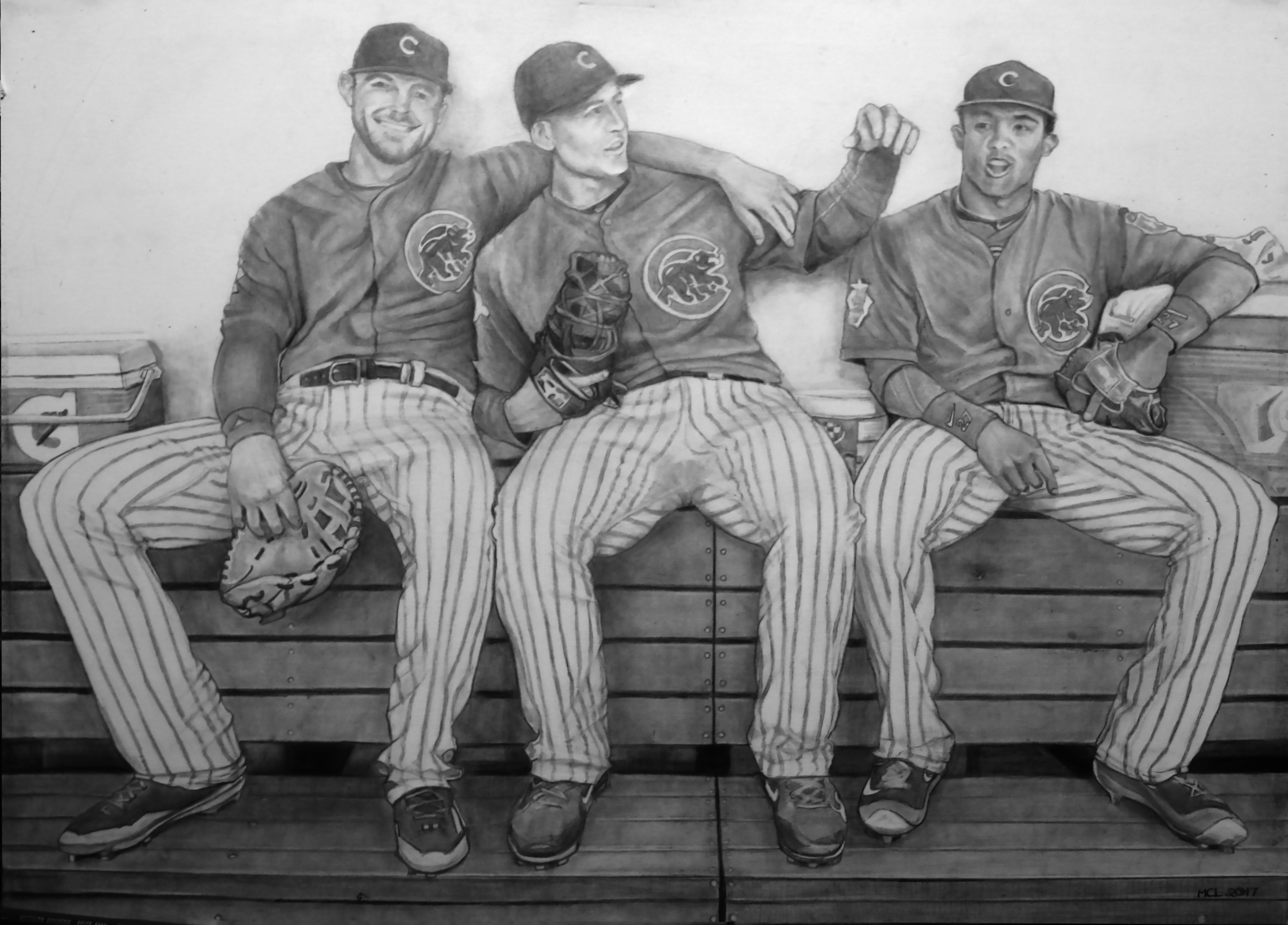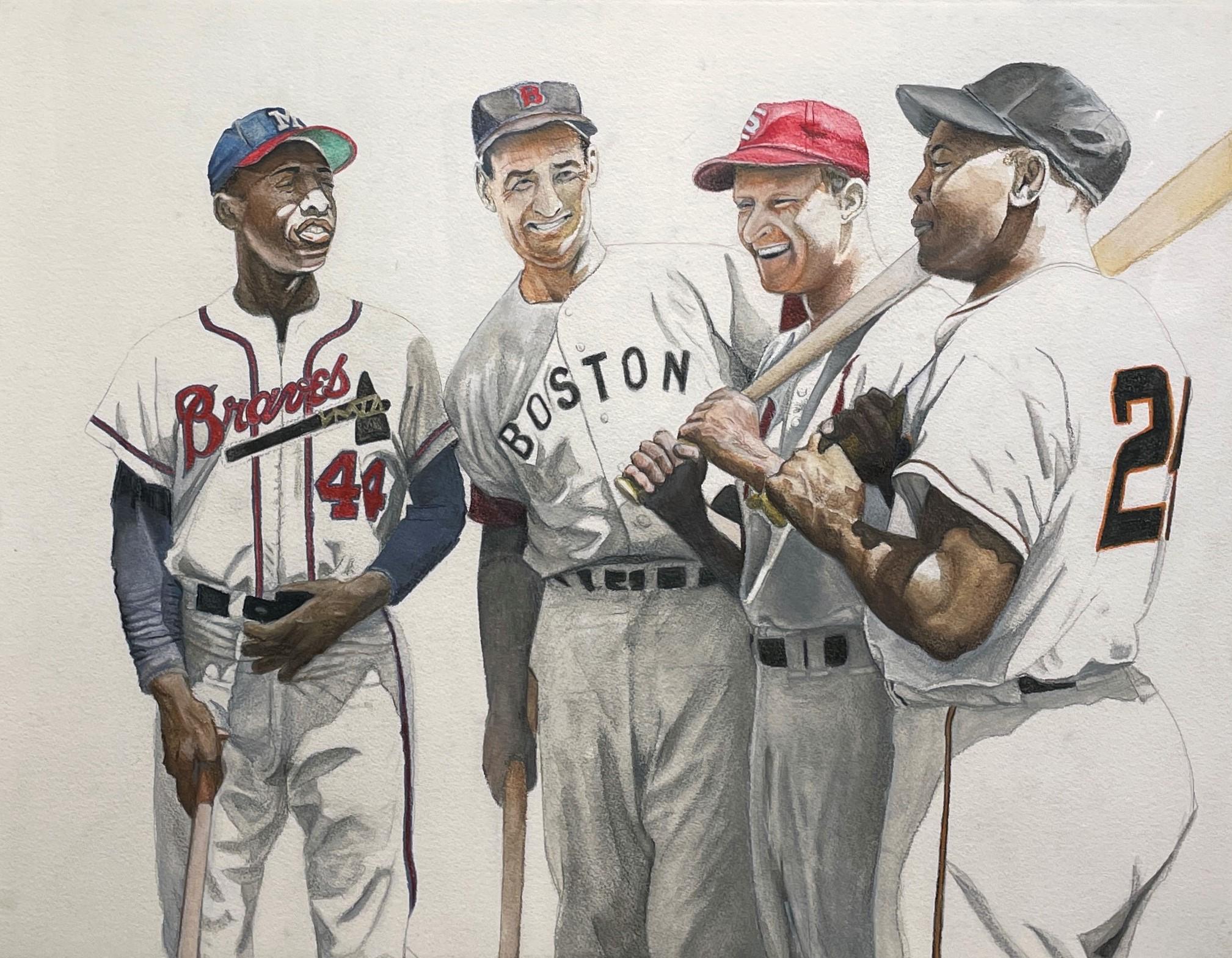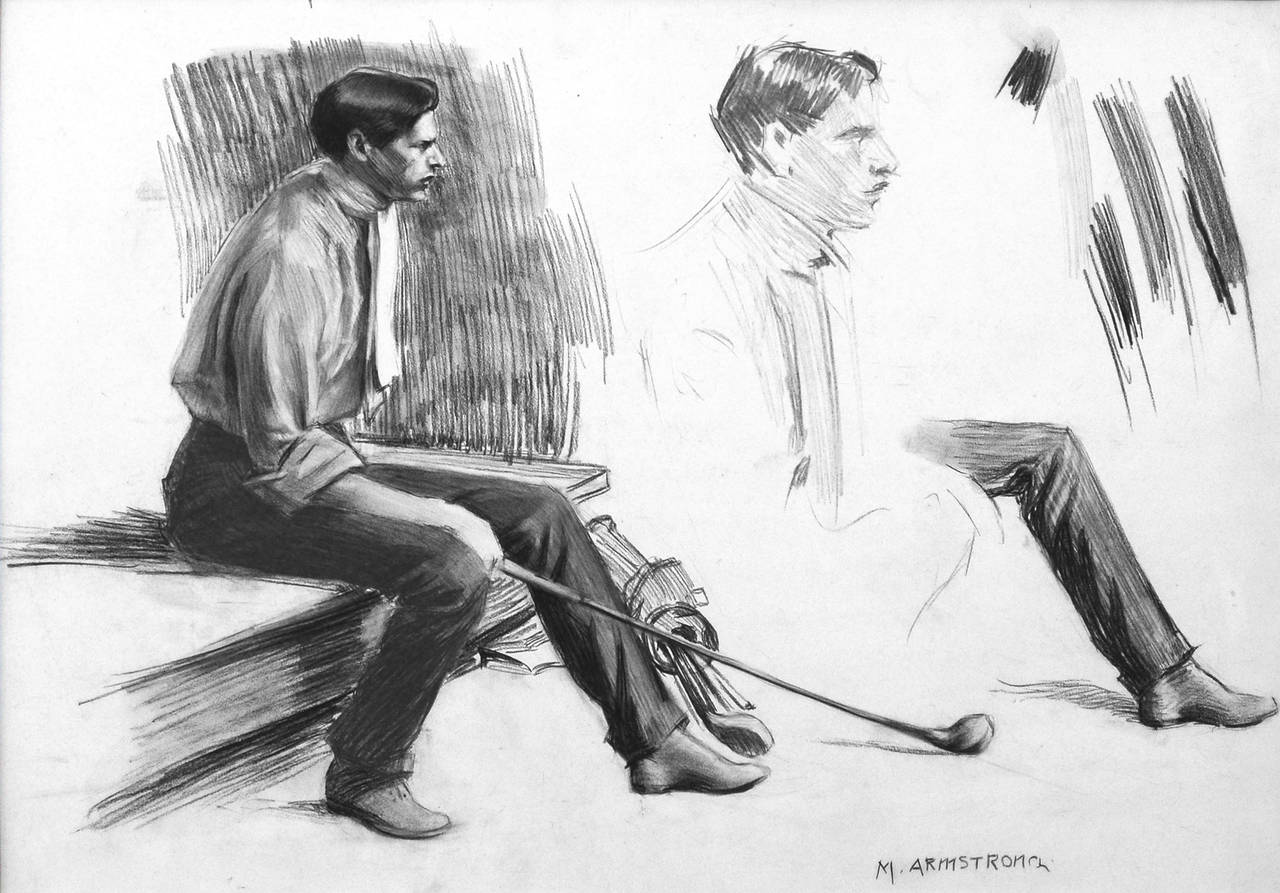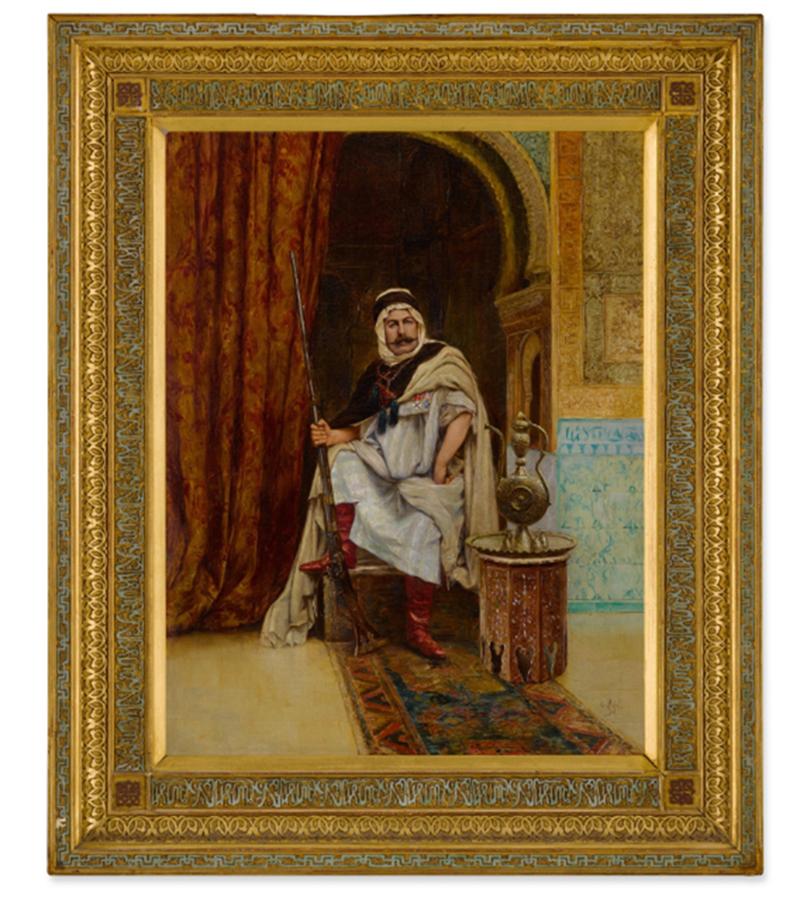Items Similar to French Romantic school, Portrait of a young soldier, drawing
Video Loading
Want more images or videos?
Request additional images or videos from the seller
1 of 13
UnknownFrench Romantic school, Portrait of a young soldier, drawingcirca 1830
circa 1830
About the Item
French Romantic school, circa 1830
Portrait of a young soldier,
pencil on paper
Framed under glass : 38 x 30 cm
It's a vintage frame, probablly original but I had the back redone
The first part of the 19th century was a golden age for portraiture. Firstly because it was less and less the preserve of an elite and because the technical mastery of portrait artists was real and important.
The success of a portrait is really - and this drawing illustrates it perfectly - to convey not only the physical aspect of a person but also their character traits. And with this portrait in particular, it seems to me that we can read the whole personality of this young soldier, who seems a little impatient and in a hurry when he has to strike a pose, and above all, sure of himself. He has all the makings of a romantic character, he could be the hero of a Stendhal novel. Without knowing anything about him, we have the impression of guessing him.
- Creation Year:circa 1830
- Dimensions:Height: 12.21 in (31 cm)Width: 8.67 in (22 cm)
- Medium:
- Movement & Style:
- Period:
- Condition:
- Gallery Location:Paris, FR
- Reference Number:
About the Seller
5.0
Platinum Seller
These expertly vetted sellers are 1stDibs' most experienced sellers and are rated highest by our customers.
Established in 2018
1stDibs seller since 2019
210 sales on 1stDibs
Typical response time: <1 hour
- ShippingRetrieving quote...Ships From: Paris, France
- Return PolicyA return for this item may be initiated within 14 days of delivery.
More From This SellerView All
- Eugène Devéria (1805-1865) The Children of the painter DrawingBy Eugene DeveriaLocated in Paris, FREugène Devéria (1805-1865) The children of the painter Portrait in an oval, study for a portrait Black pencil on paper 23 x 19 cm Stamp of the worksh...Category
1840s Romantic Portrait Drawings and Watercolors
MaterialsPencil
- Eugène Devéria (1805-1865) Young Woman Profile DrawingBy Eugene DeveriaLocated in Paris, FREugène Devéria (1805-1865) A Young Woman Profile Black pencil 21 x 19 cm Stamp of the workshop on verso Provenance: Family of the artist after an in...Category
1830s Romantic Portrait Drawings and Watercolors
MaterialsPencil
- Eugène Devéria (1805-1865) Family Portrait, 1826 DrawingBy Eugene DeveriaLocated in Paris, FREugène Devéria (1805-1865) A Family Portrait, 1826 pencil on paper Signed lower right and dated 1826 19.5 x 27 cm in a beautiful carved oak frame: 4...Category
1820s Romantic Portrait Drawings and Watercolors
MaterialsPencil
- Pierre-Georges Jeanniot (1848–1934), Henri Rochefort for a duel, drawingBy Pierre Georges JeanniotLocated in Paris, FRPierre-Georges Jeanniot (1848–1934) Portrait of Henri Rochefort ready for a duel, Pencil on paper Signed and titled lower left 28 x 21 cm In good condition : the left and right borders irregularly cut In a modern cardboard mount : 45.5 x 35 cm Henri Rochefort, whose complete name was Victor Henri de Rochefort-Luçay , was born in Paris on January 31 , 1831, he died in Aix-les-Bains on 1 st July 1913. He was a french journalist , playwright and politician A great polemicist in the pages of his newspapers ( La Lanterne , La Marseillaise , L'Intransigeant), he defended radical and even extremist political options (anticlerical , nationalist , favorable to the Commune , Boulangist , socialist and anti-Dreyfusard ) which earned him the nickname of "The man with twenty duels and thirty trials », And convictions, in particular in the prison of Noumea from which, unique fact, he managed to escape in 1874. Pierre-Georges Jeanniot (1848–1934) was a Swiss-French Impressionist painter, designer, watercolorist, and engraver who was born in Geneva, Switzerland, and died in France. His work often depicts the modern life in Paris. He started out pursuing a military career, as an infantry officer (1866–1881). He was a lieutenant with the Twenty-third Infantry from 1868 to 1870. He fought in the Franco-Prussian War, was wounded at Rezonville, and was awarded the Légion d'Honneur. He subsequently served with the Ninety-fourth Infantry and the Seventy-third Infantry. At the time he left the army he held the rank of major, with the Chasseurs à Pieds. He never ceased drawing. He was known for the first time in 1872 at the art exhibition Salon de Paris, where he presented a watercolor painting called Intérieur de forêt. The next year he presented the painting Le Vernan à Nass-sous-Sainte-Anne. From then on he was a regular contributor to the Salon de Paris, where he presented new works with views of Toulouse, Paris, Troyes, the edges of the Seine, and some portraits. In 1881, after the army offered him the rank of commandant, he resigned to devote himself exclusively to painting. He took up residence in Paris. His works from this period represent mainly scenes of military life that allowed him to forge a reputation. Jeanniot established himself permanently in 1882 and obtained his first award the following year (medal third class of the Salon de Paris) with his les Flanqueurs (1883, Musée du Luxembourg). In 1886, La ligne de feu, souvenirs de la bataille de Rezonville, remembering the Battle of Mars-La-Tour (Museum of Pau), assured his notoriety. From then on, he started to show a certain artistic independence. He then mostly portrayed Parisian women during the "Belle Epoque", women in bathing suits...Category
1870s Romantic Portrait Drawings and Watercolors
MaterialsCarbon Pencil
- French School 19th Century, Portrait of a young soldier, dated 1830, drawingLocated in Paris, FRFrench School 19th Century, Portrait of a young soldier, dated 1830, Pencil and heightenings of white and red 26 x 19.7 cm oval view examined outside the frame, in good condition I...Category
1830s Romantic Portrait Drawings and Watercolors
MaterialsCarbon Pencil
- Jules-Eugène Lenepveu (1819-1898) Portrait of a man in profile, signed drawingLocated in Paris, FRJules-Eugène Lenepveu (1819-1898) Portrait of a man in profile signed on the lower right Pencil and heightenings of white gouache on paper 19.5 x 13 cm Framed : 29 x 22.7 cm Jules-Eugène Lenepveu is of course particularly well known for his large-scale paintings, such as the one on the ceiling of the Paris Opera, but his work here is much more delicate and intimate. We recognise the artist's mastery of talent, but the play of textures, with its highlights of white that enliven and illuminate the model's face, is also very subtle. There's a particularly charming sense of life and impression of light. Jules-Eugène Lenepveu was born in Angers on 12 December 1819, on the site of the street that now bears his name, into a family of small shopkeepers. The painter showed a deep attachment to his family throughout his life through his correspondence and the many portraits of his relatives. He entered the drawing school in Angers in 1833, where he was a pupil of Jean-Michel Mercier. There he rubbed shoulders with the sculptor Ferdinand Taluet. He arrived in Paris in 1837 and entered the Beaux-Arts, where he was officially admitted to François-Édouard Picot's studio in 1838. He exhibited his work "L'Idylle" at the Salon of 1843 and, that same year, left for his first visit to Italy. He was awarded the Second Prix de Rome in 1843 for "Cincinnatus recevant les députés du Sénat" (Cincinnatus receiving the deputies of the Senate), then the First Prize in 1847 for "La Mort de Vitellius" (The Death of Vitellius). A resident at the Villa Médicis from 1848, he was surrounded by painters Alexandre Cabanel, Léon Benouville, Gustave Boulanger, Félix Barrias...Category
1860s Romantic Portrait Drawings and Watercolors
MaterialsGouache, Pencil
You May Also Like
- World Series Bench - Chicago Cubs, Bryant, Rizzo & Russell, Graphite on PaperBy Margie LawrenceLocated in Chicago, ILThe "World Series Bench" by Margie Lawrence consists of three key players in the Chicago Cubs for the long awaited World Series win in 2016. From the ...Category
2010s Contemporary Portrait Drawings and Watercolors
MaterialsGraphite, Paper
- Jimmy Archer - Baseball Great for the 1908 Chicago Cubs In A Catchers MaskBy Margie LawrenceLocated in Chicago, ILJimmy Archer was an Irish-born catcher in Major League Baseball who spent nearly his entire career with four National League teams, primarily the Chicago Cubs...Category
Early 2000s Contemporary Portrait Drawings and Watercolors
MaterialsGraphite, Paper
- Hank Aaron, Ted Williams, Stan Musial, Willie Mays, Baseball All-Stars PaintingBy Margie LawrenceLocated in Chicago, ILHank Aaron, nicknamed "Hammer" or "Hammerin' Hank", was an American professional baseball right fielder who played 23 seasons in Major League Baseball, from 1954 through 1976, primarily with the Braves Organization. Hall of Fame Induction 1982 Ted Williams was an American professional baseball player and manager. He played his entire 19-year Major League Baseball career, primarily as a left fielder for the Boston Red Sox from 1939 to 1960; his career was interrupted by military service during World War II and the Korean War. Induction into The Hall of Fame 1972 Stanley Frank Musial, nicknamed Stan the Man, was an American baseball outfielder and first baseman. He spent 22 seasons in Major League Baseball, playing for the St. Louis Cardinals, from 1941 to 1944 and from 1946 to 1963. Hall of Fame Induction 1969 Willie Howard Mays Jr., nicknamed "The Say Hey Kid", is an American former professional baseball center fielder. He spent almost all of his 22-season Major League Baseball career playing for the New York/San Francisco Giants before finishing his career with the New York Mets Hall of Fame Induction 1979 Margie Lawrence...Category
2010s Contemporary Portrait Drawings and Watercolors
MaterialsGraphite, Watercolor, Paper
- Early 20th Century Young Golfer FigurativeBy Margaret NeilsonLocated in Soquel, CAStudy of a young man with his golf clubs by listed artist Margaret Neilson Armstrong (American, 1867-1944). Image, 14"H x 20"W. Displayed in vintage mat. S...Category
1920s Realist Portrait Drawings and Watercolors
MaterialsPencil, Paper
- Clemente Pujol de Gustavino An orientalist Arab GuardsmanLocated in New York, NYArtist: Clemente Pujol de Guastavino (1850-1905) Origin: Spanish Signature: signed C. Pujol (lower right) Medium: oil on canvas Dimension: 25 1/2 in x 19 3/4 in. Framed 34 by 2...Category
19th Century Portrait Drawings and Watercolors
MaterialsOil, Canvas
- Rare Modernist Hungarian Rabbi Pastel Drawing Gouache Painting Judaica Art DecoBy Hugó ScheiberLocated in Surfside, FLRabbi in the synagogue at prayer wearing tallit and tefillin. Hugó Scheiber (born 29 September 1873 in Budapest – died there 7 March 1950) was a Hungarian modernist painter. Hugo Scheiber was brought from Budapest to Vienna at the age of eight where his father worked as a sign painter for the Prater Theater. At fifteen, he returned with his family to Budapest and began working during the day to help support them and attending painting classes at the School of Design in the evening, where Henrik Papp was one of his teachers. He completed his studies in 1900. His work was at first in a post-Impressionistic style but from 1910 onward showed his increasing interest in German Expressionism and Futurism. This made it of little interest to the conservative Hungarian art establishment. However, in 1915 he met the great Italian avant-gardist Filippo Tommaso Marinetti and the two painters became close friends. Marinetti invited him to join the Futurist Movement. The uniquely modernist style that he developed was, however, closer to German Expressionism than to Futurism and eventually drifted toward an international art deco manner similar to Erté's. In 1919, he and his friend Béla Kádar held an exhibition at the Hevesy Salon in Vienna. It was a great success and at last caused the Budapest Art Museum to acquire some of Scheiber's drawings. Encouraged, Scheiber came back to live in Vienna in 1920. A turning point in Scheiber's career came a year later, when Herwarth Walden, founder of Germany's leading avant-garde periodical, Der Sturm, and of the Sturm Gallery in Berlin, became interested in Scheiber's work. Scheiber moved to Berlin in 1922, and his paintings soon appeared regularly in Walden's magazine and elsewhere. Exhibitions of his work followed in London, Rome, La Paz, and New York. Scheiber's move to Germany coincided with a significant exodus of Hungarian artists to Berlin, including Laszlo Moholy-Nagy and Sandor Bortnyik. There had been a major split in ideology among the Hungarian avant-garde. The Constructivist and leader of the Hungarian avantgarde, Lajos Kassák (painted by Hugó Scheiber in 1930) believed that art should relate to all the needs of contemporary humankind. Thus he refused to compromise the purity of his style to reflect the demands of either the ruling class or socialists and communists. The other camp believed that an artist should be a figurehead for social and political change. The fall out and factions that resulted from this politicisation resulted in most of the Hungarian avant gardists leaving Vienna for Berlin. Hungarian émigrés made up one of the largest minority groups in the German capital and the influx of their painters had a significant effect on Hungarian and international art. Another turning point of Scheiber's career came in 1926, with the New York exhibition of the Société Anonyme, organized by Katherine Dreier. Scheiber and other important avant garde artists from more than twenty-three countries were represented. In 1933, Scheiber was invited by Marinetti to participate in the great meeting of the Futurists held in Rome in late April 1933, Mostra Nazionale d’Arte Futurista where he was received with great enthusiasm. Gradually, the Hungarian artists began to return home, particularly with the rise of Nazism in Germany. Kádar went back from Berlin in about 1932 and Scheiber followed in 1934. He was then at the peak of his powers and had a special flair in depicting café and cabaret life in vivid colors, sturdily abstracted forms and spontaneous brush strokes. Scheiber depicted cosmopolitan modern life using stylized shapes and expressive colors. His preferred subjects were cabaret and street scenes, jazz musicians, flappers, and a series of self-portraits (usually with a cigar). his principal media being gouache and oil. He was a member of the prestigious New Society of Artists (KUT—Képzőművészek Új Társasága)and seems to have weathered Hungary's post–World War II transition to state-communism without difficulty. He continued to be well regarded, eventually even receiving the posthumous honor of having one of his images used for a Russian Soviet postage stamp (see image above). Hugó Scheiber died in Budapest in 1950. Paintings by Hugó Scheiber form part of permanent museum collections in Budapest (Hungarian National Museum), Pecs (Jannus Pannonius Museum), Vienna, New York, Bern and elsewhere. His work has also been shown in many important exhibitions, including: "The Nell Walden Collection," Kunsthaus Zürich (1945) "Collection of the Société Anonyme," Yale University Art Gallery, New Haven, Connecticut (1950) "Hugó Scheiber: A Commemorative Exhibition," Hungarian National Museum, Budapest (1964) "Ungarische Avantgarde," Galleria del Levante, Munich (1971) "Paris-Berlin 1900-1930," Centre Georges Pompidou, Paris (1978) "L’Art en Hongrie, 1905-1920," Musée d’Art et l’Industrie, Saint-Etienne (1980) "Ungarische Avantgarde in der Weimarer Republik," Marburg (1986) "Modernizmus," Eresz & Maklary Gallery, Budapest (2006) "Hugó Scheiber & Béla Kádár," Galerie le Minotaure, Paris and Tel Aviv (2007) Hugó Scheiber's paintings continue to be regularly sold at Sotheby's, Christie's, Gillen's Arts (London), Papillon Gallery (Los Angeles) and other auction houses. He was included in the exhibition The Art Of Modern Hungary 1931 and other exhibitions along with Vilmos Novak Aba, Count Julius Batthyany, Pal Bor, Bela Buky, Denes Csanky, Istvan Csok, Bela Czobel, Peter Di Gabor, Bela Ivanyi Grunwald, Baron Ferenc Hatvany, Lipot Herman, Odon Marffy, C. Pal Molnar...Category
Early 20th Century Modern Figurative Paintings
MaterialsPaper, Charcoal, Pastel, Watercolor, Gouache





